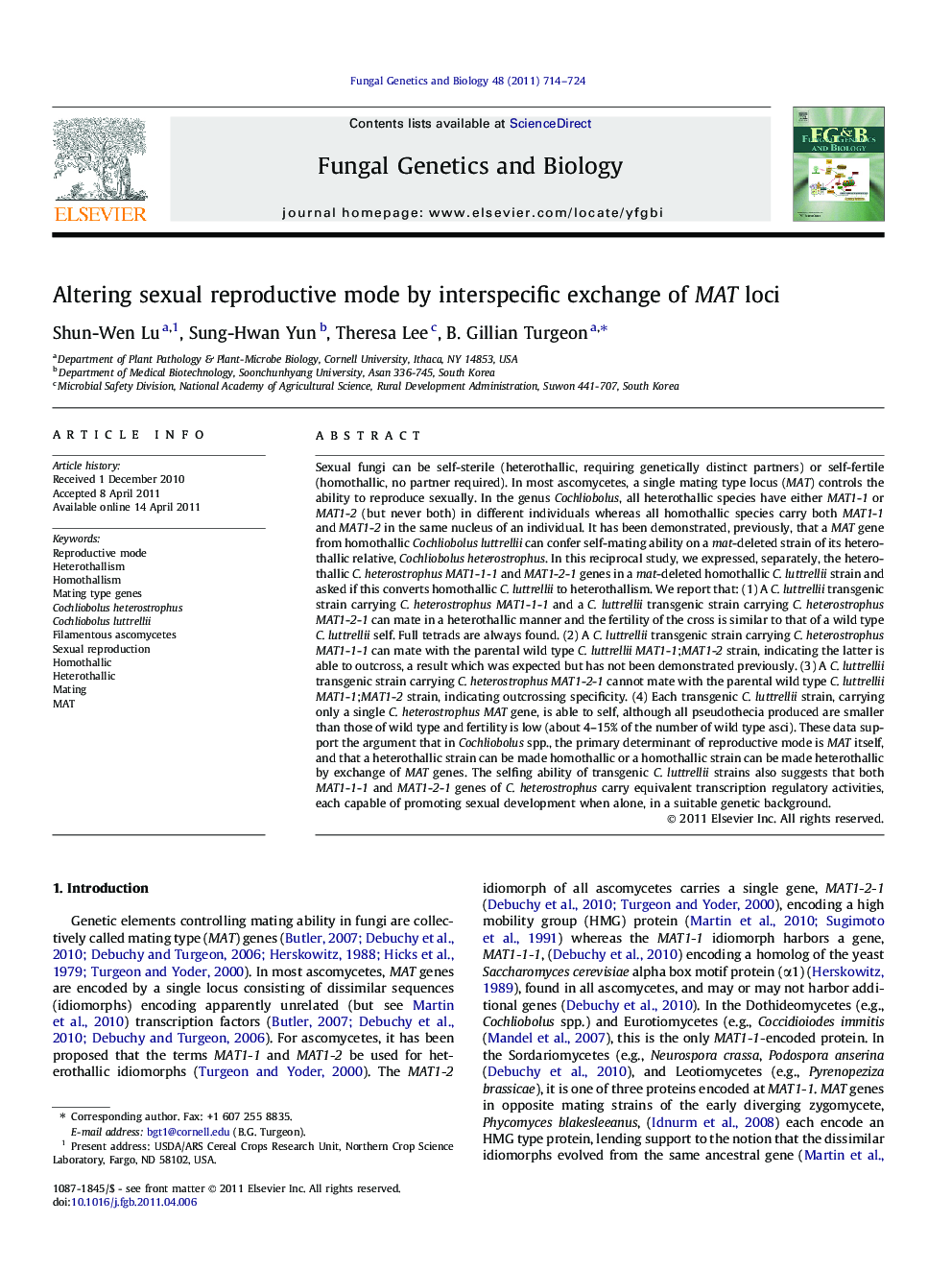| کد مقاله | کد نشریه | سال انتشار | مقاله انگلیسی | نسخه تمام متن |
|---|---|---|---|---|
| 2180983 | 1095255 | 2011 | 11 صفحه PDF | دانلود رایگان |

Sexual fungi can be self-sterile (heterothallic, requiring genetically distinct partners) or self-fertile (homothallic, no partner required). In most ascomycetes, a single mating type locus (MAT) controls the ability to reproduce sexually. In the genus Cochliobolus, all heterothallic species have either MAT1-1 or MAT1-2 (but never both) in different individuals whereas all homothallic species carry both MAT1-1 and MAT1-2 in the same nucleus of an individual. It has been demonstrated, previously, that a MAT gene from homothallic Cochliobolus luttrellii can confer self-mating ability on a mat-deleted strain of its heterothallic relative, Cochliobolus heterostrophus. In this reciprocal study, we expressed, separately, the heterothallic C. heterostrophus MAT1-1-1 and MAT1-2-1 genes in a mat-deleted homothallic C. luttrellii strain and asked if this converts homothallic C. luttrellii to heterothallism. We report that: (1) A C. luttrellii transgenic strain carrying C. heterostrophus MAT1-1-1 and a C. luttrellii transgenic strain carrying C. heterostrophus MAT1-2-1 can mate in a heterothallic manner and the fertility of the cross is similar to that of a wild type C. luttrellii self. Full tetrads are always found. (2) A C. luttrellii transgenic strain carrying C. heterostrophus MAT1-1-1 can mate with the parental wild type C. luttrellii MAT1-1;MAT1-2 strain, indicating the latter is able to outcross, a result which was expected but has not been demonstrated previously. (3) A C. luttrellii transgenic strain carrying C. heterostrophus MAT1-2-1 cannot mate with the parental wild type C. luttrellii MAT1-1;MAT1-2 strain, indicating outcrossing specificity. (4) Each transgenic C. luttrellii strain, carrying only a single C. heterostrophus MAT gene, is able to self, although all pseudothecia produced are smaller than those of wild type and fertility is low (about 4–15% of the number of wild type asci). These data support the argument that in Cochliobolus spp., the primary determinant of reproductive mode is MAT itself, and that a heterothallic strain can be made homothallic or a homothallic strain can be made heterothallic by exchange of MAT genes. The selfing ability of transgenic C. luttrellii strains also suggests that both MAT1-1-1 and MAT1-2-1 genes of C. heterostrophus carry equivalent transcription regulatory activities, each capable of promoting sexual development when alone, in a suitable genetic background.
► Expression of heterothallic MAT in a mat-null homothallic relative renders it heterothallic.
► mat-deleted homothallic strains carrying a single heterothallic MAT show outcrossing specificity.
► MAT alone controls reproductive mode.
► mat-deleted homothallic strains carrying a single heterothallic MAT can self mate.
Journal: Fungal Genetics and Biology - Volume 48, Issue 7, July 2011, Pages 714–724